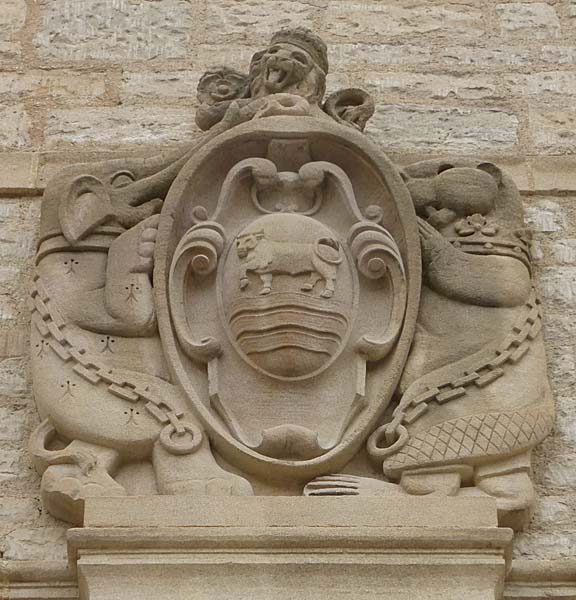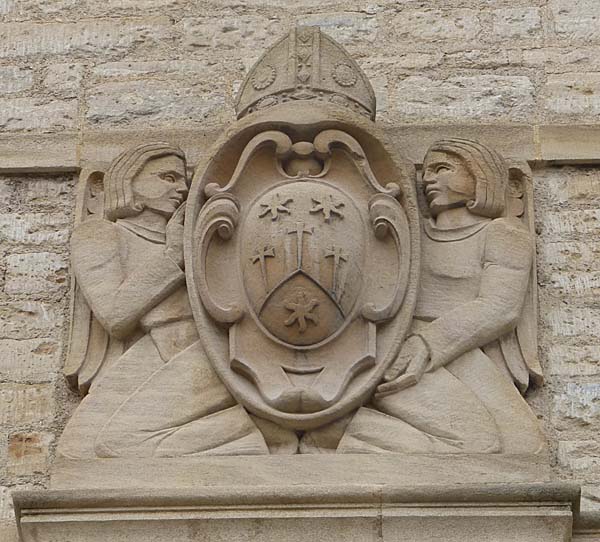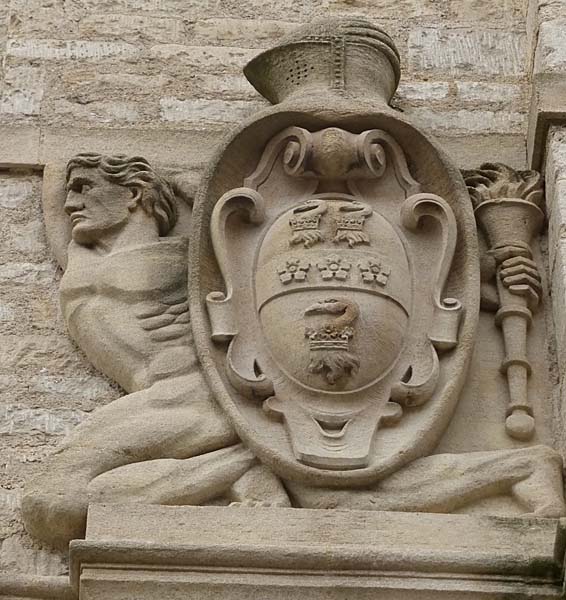| Architect |
Wilkinson Eyre |
| Date
Built |
Completed
2015 |
| Location |
The Broad |
| Description |
|
Oxford University's New
Bodleian Library, designed by Giles Gilbert
Scott and completed in 1940, has undergone a
£50M transformation to a design by Wilkinson
Eyre. The Library says of this project
that, "...
The design set forward by Wilkinson
Eyre Architects for the building's
renovation, which commenced in 2011,
aimed to respect the building's heritage
while modernising its infrastructure and
providing better facilities for students
and researchers, as well as greater
opportunities for collaboration and
outreach with the wider
community." Along the way
it has also changed names and is now known
as the Weston Library to reflect a major
financial donation to the project by
Garfield Weston.  ... and a series of shallow steps that are already attracting people who use them to eat lunch or just sit in the sun.   Wilkinson Eyre say of
their work on the library that, "...In
2006 Wilkinson Eyre was appointed to
refurbish the library as a new
cultural and intellectual
landmark. A particularly
exciting aspect of the project is
the opening up of the building to
allow more public access and
engagement in the activities within.
This will include the creation of
new spaces for a programme of
exhibitions and seminars drawing on
the extraordinary resources of the
Bodleian’s collections. The
design works with, rather than
against, Scott’s robust design,
reinvigorating the space with an
improved circulation diagram – for
both book retrieval and user
movement – and creating a number of
contemporary interventions,
including a spectacular reading room
at roof level."
        ***************** Access
to the upper floors of the library is
still restricted to readers but the
ground floor is now a spectacular public
space called the Blackwell Hall.
 Within the hall are a
café, an information desk and a number
of displays. Leading off from the
hall are exhibition spaces, a lecture
theatre and the library shop.
   You also get glimpses
of the book stacks on the floor above,
some of which are carried across the
hall on glass-walled bridges.
      ************ The facade of the
building is decorated with 21 cartouches
that contain the coats of arms of a
number of people associated with the
university and/or the library.
According to the "headington.org.uk"
website, these are, in order starting
from the left hand end of the facade on
The Broad and carrying on around the
corner on Parks Road:
Sir Giles Gilbert Scott, the building's architect  Sir Edmund Craster, a British librarian, who served as Bodley's Librarian from 1931 to 1945.  Lord Halifax, who was educated at Christ Church, then became a Fellow of All Souls College, Oxford  Viscount Grey, Chancellor of the University of Oxford from 1928 to 1933  The City of Oxford,  The Stationers’ Company  Cecil Rhodes: In his
last will and testament he provided for
the establishment of the famous Rhodes
Scholarship, the world's first
international study program. The
scholarship enabled students from
territories under British rule or
formerly under British rule and from
Germany to study at Rhodes's alma mater,
the University of Oxford.
 John Radcliffe: He
graduated from the University of
Oxford, where he was an exhibitioner
Fellow of Lincoln College. He
was a physician, academic and
politician. A number of landmark
buildings in Oxford are named after
him including: the Radcliffe Camera,
the Radcliffe Observatory, and the
John Radcliffe Hospital. On his
death his property was bequeathed to
various charitable causes, including
University College, Oxford.
 Duke Humfrey: The
younger son of Henry IV. He was a
connoisseur of literature and
commissioned translations of classical
works from Greek into Latin. When he
died in 1447, he donated his
collection of 281 manuscripts to the
University of Oxford.
 Thomas de Cobham: According to the Bodleian Library's website, "The first library for Oxford University – as distinct from the colleges – was housed in a room above the Old Congregation House, begun c.1320 on a site to the north of the chancel of the University Church of St Mary the Virgin. The building stood at the heart of Oxford’s ‘academic quarter’, close to the schools in which lectures were given. The library was built with funds supplied by Thomas de Cobham, Bishop of Worcester, but was still unfinished when he died in 1327."  William Laud, went
in 1589 to St John's College, Oxford.
In 1593 he became a fellow of the
college. Laud was a major
collector of manuscripts.
 William Herbert
the 3rd Earl of Pembroke 1580 – 1630,
Chancellor of the University of Oxford
and founder of Pembroke College. The
First Folio of William Shakespeare's
plays was dedicated to him, together
with his brother, Philip Herbert.
 Sir Kenelm
Digby: He went to Gloucester Hall,
Oxford in 1618, where he was
taught by Thomas Allen. Allen
bequeathed to Digby his library, and
he in turn, donated it to the Bodleian.
 Richard Rawlinson,
(1690 – 1755) was an English clergyman
and antiquarian collector of books and
manuscripts, which he bequeathed to
the Bodleian Library.
 Francis Douce,
(1757 - 1834), he left his printed
books, illuminated manuscripts, coins
&c., to the Bodleian Library
 The University of
Oxford
 John Selden, (1584
- 1654), assembled a famous library,
that in 1659 became part of the
Bodleian Library's collections
 Thomas Tanner: His valuable collection of books and manuscripts is in the Bodleian Library.  Richard Gough,
(1735 - 1809), his books and
manuscripts relating to Anglo-Saxon
and northern literature, all his
collections in the department of
British topography, and a large number
of his drawings and engravings of
other archaeological remains, were
bequeathed to the University of
Oxford. Notable in the
bequest is the so-called Gough Map, an
outstanding medieval map of Britain,
which is now known by Gough’s name.
 Lord Sunderlin:
The Shakespearian scholar Edmund
Malone (1741 - 1812), bequeathed his
library to his brother, Lord
Sunderlin, who presented it to the
Bodleian in 1815.
 Thomas, 2nd Earl
Brassey, (1863 - 1919), educated at
Balliol College, Oxford, he became a
British peer, who was for many years
editor or joint editor of Brassey's
Naval Annual.
 |
|
|
Weston
Library, Oxford, UK
 |
